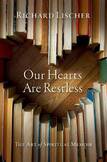Review: The invitation to everyday holiness found in spiritual memoirs
Many years ago, I had the opportunity to teach a course on spiritual memoir at a Jesuit university. Eighteen students and I spent the semester reading selections from St. Augustine to Dorothy Day to Tim Tebow. (You’ve never read Tebow’s Through My Eyes? Don’t, it’s terrible.) In lieu of a traditional final exam, I asked the students to write their own 15-page spiritual memoir. Because many of them were graduating seniors and had more or less checked out by mid-March, I did not have high hopes.
I was wrong. Students who were not always articulate when analyzing literature or evaluating the interior lives of noted spiritual writers proved to be remarkably eloquent and insightful on the subject of their own. They identified struggles with belief, emotional and mental breakthroughs, cathartic realizations about the faults (or sacrifices) of their parents and mentors, the reverberations of personal traumas, and even the occasional moments of unexpected grace in their lives. I was impressed by the depth of their reflections—and somewhat taken aback by their vulnerability and honesty in relating such personal stories to a teacher.
In Richard Lischer’s Our Hearts Are Restless: The Art of Spiritual Memoir, the author notes that “spiritual memoir is an intimate genre, perhaps the most intimate.” Further, engaging with the spiritual memoirs of others seems to work as a goad for every reader to do some self-reflection. As Lischer writes of the more than 20 authors (all Christians) whose memoirs he covers in Our Hearts Are Restless, “they had become my friends. As with any friend, I became involved in their lives.” Further, he writes, “I interrogated their lives for the meaning of my own.”
In Richard Lischer’s Our Hearts Are Restless: The Art of Spiritual Memoir, the author notes that “spiritual memoir is an intimate genre, perhaps the most intimate.”
Readers of his book, I suspect, will find themselves doing the same, interrogating Lischer’s analyses of the stories within for glimpses of meaning in their own, as Lischer offers apt interventions and careful focus on particular themes to guide us through the memoirs in question. An emeritus professor at Duke Divinity School, Lischer is also a Lutheran pastor and the author of numerous books on preaching. He has written two spiritual memoirs himself as well: Open Secrets: A Memoir of Faith and Discovery and Stations of the Heart: Parting With a Son.
In Our Hearts Are Restless, he separates the memoirs under investigation according to seven themes, some of which are expected, like “search and surrender” or “pilgrimages,” and others startling but insightful, like “nomadic faith” and “stripping of the altars.” That last refers to stories where ruin comes before insight or redemption or wisdom or grace—or where the removal of all earthly optimism (as with Etty Hillesum or Dietrich Bonhoeffer) spurs an embrace of a theological hope. The authors covered, too, run the gamut from the expected, like St. Augustine and Thomas Merton and St. Thérèse of Lisieux, to the more surprising, like Richard Rodriguez and Abélard and Héloïse.
One caveat for readers: In Our Hearts Are Restless Lischer is exploring the art of spiritual memoir, not necessarily the content of them. He is interested in questions that normally might not arise in the course of devotional reading or reading for enjoyment. How is the story constructed? Where are the turning points, the moments of metanoia, the darkness before the dawn? How does the author bring it home, so to speak? As such, Our Hearts is not so much an introduction to the spiritual memoir as a study of the craft of their composition.
This approach provides new insights into stories that are otherwise perhaps well-known, like those of St. Augustine or C. S. Lewis, and also serves to complicate any preconceived notions the reader might have about the narrative arc of spiritual memoirs in general. Lischer notes in the epilogue that while we may assume the story of St. Paul’s conversion on the road to Damascus “provides the normative plot for Christian autobiography, that assumption deserves a closer look.” In some cases, the defining moment is escape from sin; in others, the author seeks a cure for restlessness; in still others (including the story of St. Paul himself), there is a shocking intervention from God that completely changes an existence lived until then with certainty and conviction. Not every pilgrim, in other words, starts out without a previous world of meaning.
St. Thérèse of Lisieux's memoir "is the most intimate and imitable of all the spiritual memorists,” Lischer writes.
Many of the most famous sainthood stories in our Catholic tradition—including those of St. Francis of Assisi and St. Ignatius Loyola—are tales of conversion from dissolute living to a kind of militant asceticism. The story writes itself, from the callow youth immersed in vice to the penitent hurling himself into a thorn bush to mortify the flesh. Even today, some Catholics (intentionally or not) distort or diminish the power of the witness of Dorothy Day by depicting her holiness as a story of redemption from a life of sin, an approach that tends to diminish her prophetic voice. Yet she—like many of Lischer’s subjects—hardly fits smoothly into such a narrative.
Another example that confounds the traditional memoir narrative—and to my mind the most remarkable treatment in Lischer’s book—is the story of St. Thérèse of Lisieux, which Lischer locates along with those of Harriet Jacobs, Dorothy Day and Kathleen Norris under the rubric of “Pilgrimages” (a clever irony, as the convent Thérèse entered at 15 and left only at her death at 24 was less than a mile from her father’s home). Lischer points out that Thérèse’s primary accomplishment is a “heartfelt but artless autobiography” of a woman who “made no mark, achieved no advancement, and left no footprint in the world.” And yet now, 125 years after her death, she is one of the most venerated saints in France and worldwide, called by Pope Pius X “the greatest saint of modern times” and named a doctor of the church by Pope John Paul II. Indeed, Lischer notes, “[t]here are more statues of St. Thérèse in American churches than anyone save the Virgin Mary. How did this happen?”
The answer, of course, lies in that “artless autobiography,” The Story of a Soul, which has captured the hearts and the imaginations of millions since its publication in 1898, a year after St. Thérèse’s death (she was canonized 27 years later). Her account of her nine years in a convent where her own sister was the no-nonsense prioress remains a best-seller today. Written as she was suffering from the tuberculosis that would kill her, The Story of a Soul begins as simple childhood memoir (one heavily rewritten by her prioress sister) but progresses to a spiritual manual of sorts on how to experience divine love through the “Little Way”: simple daily acts of penance, obedience and humility. One important detail? It all takes place in the context of a community of 26 women living in close quarters, seeking holiness but also driving each other mad. (One of Thérèse’s early spiritual disciplines is to show kindness to a fellow nun whose teeth-clicking she finds infuriating.)
“She is the most intimate and imitable of all the spiritual memorists,” Lischer writes, in part because there is no pretense to her story. “By narrating the smallest and least complicated moments in her own life, Thérèse opens a door onto everyday holiness and invites the least of us to enter.”
And perhaps it is in that invitation—come through this door into everyday holiness—that the true genius and enduring popularity of spiritual memoir can be found.











